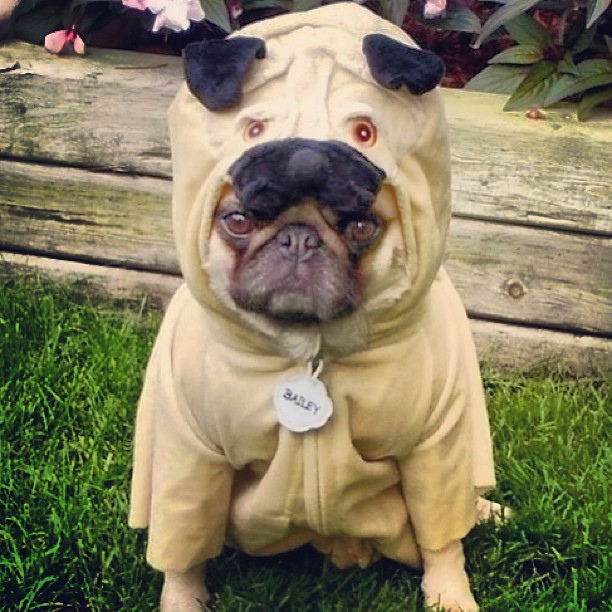Pet Health
03/27/2023
Upper Respiratory Infections in Dogs
This past fall and winter, the news was inundated with reports of a canine cough outbreak. In February of this…
Monday – Friday
7:00 am – 7:00 pm
Saturday
7:00 am – 6:00 pm
Sunday
9:00 am – 6:00 pm
Monday – Friday
7:00 am – 7:00 pm
Saturday
7:00 am – 6:00 pm
Sunday
9:00 am – 6:00 pm

You’re proud of your little Pug, even if her legs are a little long and her tail doesn’t actually curl all that much and that one ear wants to stand up… But hey, she’s ADORABLE and she’s your best friend! That’s really all that matters. But how can you tell if your pup is a purebred? Even if your breeder says she’s a purebred and you have the papers to prove it, you may have a mutt!
What are papers? Papers are simply a dog registration. A registration certificate will tell you the name of your pup’s mom and dad and the date when she was born. Your certificate may come from the AKC (American Kennel Club), or the UKC (United Kennel Club).
Unfortunately, the registration is not a guarantee of a pure breed. As long as the pup’s Mom and Dad (“Dam” and “Sire”) are registered, their puppies are eligible for a registration certificate, too.
Papers may also refer to pedigree. Pedigree is a history of your dog’s grandparents, great grandparents, and so on. It’s just a list of names, and, regrettably, that doesn’t guarantee anything either. The truth is, in order for a dog to get registration papers or a pedigree, he does not have to meet any qualifications of appearance, health, temperament, or any of those things you may look for in a purebred. AKC or UKC registered puppies purchased from a backyard breeder or a pet store won’t be the same quality as a dog purchased from a reliable breeder.
Whether you’ve had your faithful companion for years or you just brought home a puppy, there are a few reliable ways to check if they’re a purebred:
Every breed has a set of standards for physical appearance and personality. These standards were developed by the dog’s national breed club and then approved by the American Kennel Club (AKC).
Breed standards best describe the breed’s coat, colors, markings, gait, structure, temperament, and more. For example, some of the AKC’s Pug standards read:
A dog that does not meet the standards for his breed is either subnormal of the breed, or simply is not what he’s supposed to be—at least by the AKC’s official definitions.
Does your dog measure up? Find the standards and compare them to your dog. Be brutally honest. It could hurt, but it’s the best way to know if your dog is purebred.
An experienced veterinarian can usually give you some idea about your pup’s origin. Not only have they seen so many different breeds come through their door, but many vets also treat breed-specific conditions and medical issues. All breeds come with their own specific health issues. For example, Boston Terriers are susceptible to airway obstruction disorders and abnormal tracheas. German Shepherds are prone to chronic eczema and hip dysplasia. Jack Russel Terriers are often predisposed to glaucoma. Your pet’s health characteristics may help determine its lineage.
Believe it or not, dog DNA testing was not designed to determine if a dog is a purebred. The test was designed to identify breeds found in the genetic composition of mixed breed dogs. However, in some DNA testing labs, additional tests can be performed that compare how closely your dog’s DNA profile matches to a specific breed.
Not all DNA tests are created equal, however. Many of the dog DNA tests currently on the market only recognize about 100 of the 300+ registered breeds and are simply not accurate. The more breeds in a company’s database, the better the results. Keep in mind, though, the kennel clubs govern the definition of purity, not test results.
Check with your vet for his advice on genetic testing.
If you learn your supposed purebred does not fit the bill, so what? You love them, right? Your pup will remain devoted to you for life. That’s way more important than simply being able to say your dog is a purebred. In the long run, it will not matter if your furry soulmate does not come from a pristine bloodline.
If you’re smitten with the idea of having a purebred dog and are in the market, chances are there is a breed-specific rescue group or shelter in your area with just the right pup in need of a family. According to statistics, about 25% of dogs who enter shelters are purebreds. It is likely, with research, you will find exactly the dog you are looking for within a rescue group. Plus, by rescuing, you’ll have the added benefit of knowing you have actually saved the life of a puppy.
Pet Health
03/27/2023
This past fall and winter, the news was inundated with reports of a canine cough outbreak. In February of this…